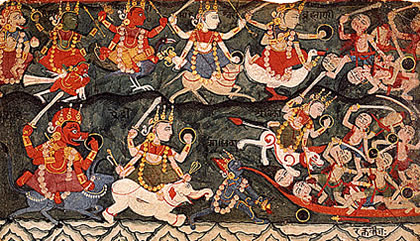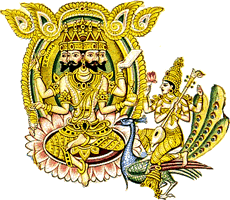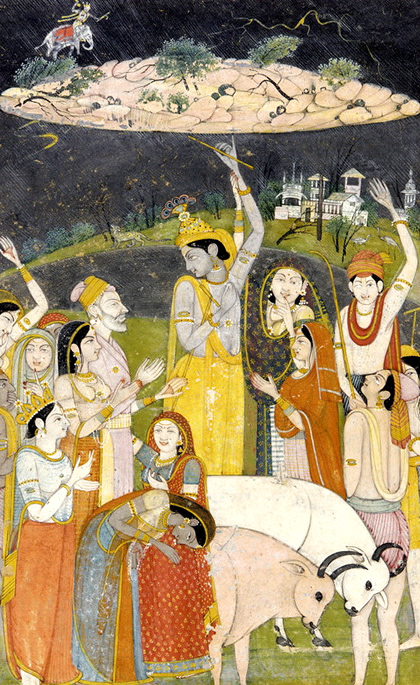World History
The puranas (ancient lore) are a genre of the religious literature of India. They were the scriptural basis for the development of many of the Hindu sects. The name purana is derived from a Sanskrit word meaning “old stories.†There are a great many puranas, but only 18 are considered as the authoritative core of the form of Hindu sacred writing, known as the Puranas.
They developed into the popular literature about gods and goddesses (such as Sati and Parvati) to which the people even of the lowest castes could become devoted (bhakti). The Puranas are smriti (remembered) texts.
The Vedas, in contrast, were shruti (heard) by the ancient rishis (holy men). The Vedas were for the “twice born†of the highest caste and were felt to not be for the lower castes. The Puranas became the sacred literature of many of the lower castes for whom the Vedas were a closed book.
Tradition set the main Puranas as the great 18 (mahapurana). There are an enormous number of upapuranas (secondary or smaller puranas). Eighteen upapuranas were chosen to be the Upa-Paranas, which attached “beneath†their respective purana.
The vast body of writings that became the Puranas began as a body of oral traditions. Since they were not the exclusive preserve of a priestly class they enjoyed wide circulation.
As a result there are many versions and variants of the Puranas. Some of these can be traced to the Mauryan dynasty. However, the Puranas are only clearly known historically from the Gupta dynasty (c. 320–500) and beyond.
The Puranas tell about the gods and goddesses of India. They are chiefl y concerned with the divine order of the world, which is told in stories. These stories are often theogonies, cosmogonies, and cosmologies that explain the origin of the gods and the world.
They also include legends about ancient kings, saints, and royal dynasties. Some sections are devoted to law, science, history, medicine, dance, and religious discussions on iconography and astrology. They form the basis of Hindu mythology.
The Puranas are central to bhakti (devotion) in Hindu religious development and practice. They are the central scriptures for the worshipers of Brahma, Vishnu, and Shiva (Siva). The Puranas have been organized into Bhramana-Puranas, Vishnava-Puranas, and Shaiva-Puranas.
In the Puranas the Trimurti (three modes of the one ultimate) of Brahma (creator), Vishnu (preserver), and Shiva (destroyer) are presented in ways that related to the common people. This enabled them to develop a vital spirituality.
There are six Brahmana-Puranas: Brahma-Purana, Brahmavaivarta-Purana, Vamana-Purana, BrahmandaPurana, Markandeya-Purana and Bhavishya-Purana. The six Vaishnava-Puranas are Vishnu-Purana, Bhagavata-Purana, Padma-Purana, Narada-Purana, Garuda-Purana, and Varaha-Purana.
The six Shaiva-Puranas are Matsya-Purana, LingaPurana, Skanda-Purana, Kurma-Purana, Shiva-Purana, and Agni-Purana. The devotees of each of the three Trimurti separated themselves into sects of Brahma, Vishnu, and Shiva.
However, almost everyone who became a devotee chose either Vishnu or Shiva. The oldest Purana is the Vayu-Purana. Some scholars believe that it originated in the 500s. Most Puranas developed between the 500s to the 1300s.
The Vayu-Purana is substituted for the Agni-Purana on occasions. The most famous of the Puranas are the Vishnu-Purana and the Bhagavata-Purana. The Bhagavata-Purana (10th century) was written in south India.
It tells the story of Krishna. In it he declares that devoted hearts move him more than yoga, brilliant logic, Vedic chanting, ascetic practices, or brilliant logic. It has been of enormous importance in the religious development of India.
The Puranas are set in the Kali Yuga or post-Vedic age, tradition said began in 3102 b.c.e. The Puranas assume that it is a period of degeneration. Human spirituality has reached a low ebb; however, the gods (devas) give mercy to humanity through devotion (bhakti). Most of the Puranas have five characteristics (pancha-lakshana) or themes.
The themes are creation, destruction, and renewal of the world; genealogies of gods and heroes (vamsa); the deeds of various gods and heroes (vamsyanucarita); the rule of the various Manus during the various stages of human development, and the life and works of the descendants of the Manus (manvantara). Some Puranas, however, do not carry this form. Many of them are like encyclopedias—filled with a mass of material on a variety of subjects.
In addition to the Puranas and the Upa-Puranas there are a number of Sthala-Puranas. The Sthala-Puranas are associated with the history and spiritual power of sacred sites (sthala).
- Bhakti Movements (devotional Hinduism)
Bhakti Movements (Devotional Hinduism) The word bhakti is derived from a Sanskrit word for “sharing.†It was used to describe a new type of path to moksha (“liberation from the cycle of reincarnationsâ€). Bhakti devotees (bhaktas)...
- Chenla
Chenla army Two successive kingdoms with strong Indian influence emerged during the pre-Angkorean centuries of Khmer history. These were the Funan, from the second to sixth centuries, and Kambuja (Chenla, Zhenla in Chinese) from the sixth to the eighth...
- Hindu Epic Literature
Hindu Epic Literature The most famous Hindu epic literature arose in India during the Vedic period (c. 1000–c. 500 b.c.e), which helped define the essentials of Indian belief and culture. While Hinduism is not the sole religion in the region, these...
- Tamil Culture
Tamil Culture Tamil is a Dravidian language group that originated in southern India and is not linked to the northern Aryan language group. Tamil speakers are found in Tamilnadu, the region surrounded by Kerela, Karnataka, and Pradesh and parts of present-day...
- Delhi And Agra
Red Fort in Delhi Delhi, now the capital of India, has been the political center of Indian civilization for over a thousand years. The settlement known as Indraprastha, which was mentioned in the Indian epic the Mahabharata, was located at modern-day...
World History
Puranas
 |
| Puranas |
The puranas (ancient lore) are a genre of the religious literature of India. They were the scriptural basis for the development of many of the Hindu sects. The name purana is derived from a Sanskrit word meaning “old stories.†There are a great many puranas, but only 18 are considered as the authoritative core of the form of Hindu sacred writing, known as the Puranas.
They developed into the popular literature about gods and goddesses (such as Sati and Parvati) to which the people even of the lowest castes could become devoted (bhakti). The Puranas are smriti (remembered) texts.
The Vedas, in contrast, were shruti (heard) by the ancient rishis (holy men). The Vedas were for the “twice born†of the highest caste and were felt to not be for the lower castes. The Puranas became the sacred literature of many of the lower castes for whom the Vedas were a closed book.
  |   |
Tradition set the main Puranas as the great 18 (mahapurana). There are an enormous number of upapuranas (secondary or smaller puranas). Eighteen upapuranas were chosen to be the Upa-Paranas, which attached “beneath†their respective purana.
The vast body of writings that became the Puranas began as a body of oral traditions. Since they were not the exclusive preserve of a priestly class they enjoyed wide circulation.
As a result there are many versions and variants of the Puranas. Some of these can be traced to the Mauryan dynasty. However, the Puranas are only clearly known historically from the Gupta dynasty (c. 320–500) and beyond.
 |
| Brahma and saraswati |
They also include legends about ancient kings, saints, and royal dynasties. Some sections are devoted to law, science, history, medicine, dance, and religious discussions on iconography and astrology. They form the basis of Hindu mythology.
The Puranas are central to bhakti (devotion) in Hindu religious development and practice. They are the central scriptures for the worshipers of Brahma, Vishnu, and Shiva (Siva). The Puranas have been organized into Bhramana-Puranas, Vishnava-Puranas, and Shaiva-Puranas.
In the Puranas the Trimurti (three modes of the one ultimate) of Brahma (creator), Vishnu (preserver), and Shiva (destroyer) are presented in ways that related to the common people. This enabled them to develop a vital spirituality.
There are six Brahmana-Puranas: Brahma-Purana, Brahmavaivarta-Purana, Vamana-Purana, BrahmandaPurana, Markandeya-Purana and Bhavishya-Purana. The six Vaishnava-Puranas are Vishnu-Purana, Bhagavata-Purana, Padma-Purana, Narada-Purana, Garuda-Purana, and Varaha-Purana.
The six Shaiva-Puranas are Matsya-Purana, LingaPurana, Skanda-Purana, Kurma-Purana, Shiva-Purana, and Agni-Purana. The devotees of each of the three Trimurti separated themselves into sects of Brahma, Vishnu, and Shiva.
However, almost everyone who became a devotee chose either Vishnu or Shiva. The oldest Purana is the Vayu-Purana. Some scholars believe that it originated in the 500s. Most Puranas developed between the 500s to the 1300s.
The Vayu-Purana is substituted for the Agni-Purana on occasions. The most famous of the Puranas are the Vishnu-Purana and the Bhagavata-Purana. The Bhagavata-Purana (10th century) was written in south India.
 |
| Krishna in Bhagavata-Purana |
It tells the story of Krishna. In it he declares that devoted hearts move him more than yoga, brilliant logic, Vedic chanting, ascetic practices, or brilliant logic. It has been of enormous importance in the religious development of India.
The Puranas are set in the Kali Yuga or post-Vedic age, tradition said began in 3102 b.c.e. The Puranas assume that it is a period of degeneration. Human spirituality has reached a low ebb; however, the gods (devas) give mercy to humanity through devotion (bhakti). Most of the Puranas have five characteristics (pancha-lakshana) or themes.
The themes are creation, destruction, and renewal of the world; genealogies of gods and heroes (vamsa); the deeds of various gods and heroes (vamsyanucarita); the rule of the various Manus during the various stages of human development, and the life and works of the descendants of the Manus (manvantara). Some Puranas, however, do not carry this form. Many of them are like encyclopedias—filled with a mass of material on a variety of subjects.
In addition to the Puranas and the Upa-Puranas there are a number of Sthala-Puranas. The Sthala-Puranas are associated with the history and spiritual power of sacred sites (sthala).
- Bhakti Movements (devotional Hinduism)
Bhakti Movements (Devotional Hinduism) The word bhakti is derived from a Sanskrit word for “sharing.†It was used to describe a new type of path to moksha (“liberation from the cycle of reincarnationsâ€). Bhakti devotees (bhaktas)...
- Chenla
Chenla army Two successive kingdoms with strong Indian influence emerged during the pre-Angkorean centuries of Khmer history. These were the Funan, from the second to sixth centuries, and Kambuja (Chenla, Zhenla in Chinese) from the sixth to the eighth...
- Hindu Epic Literature
Hindu Epic Literature The most famous Hindu epic literature arose in India during the Vedic period (c. 1000–c. 500 b.c.e), which helped define the essentials of Indian belief and culture. While Hinduism is not the sole religion in the region, these...
- Tamil Culture
Tamil Culture Tamil is a Dravidian language group that originated in southern India and is not linked to the northern Aryan language group. Tamil speakers are found in Tamilnadu, the region surrounded by Kerela, Karnataka, and Pradesh and parts of present-day...
- Delhi And Agra
Red Fort in Delhi Delhi, now the capital of India, has been the political center of Indian civilization for over a thousand years. The settlement known as Indraprastha, which was mentioned in the Indian epic the Mahabharata, was located at modern-day...
